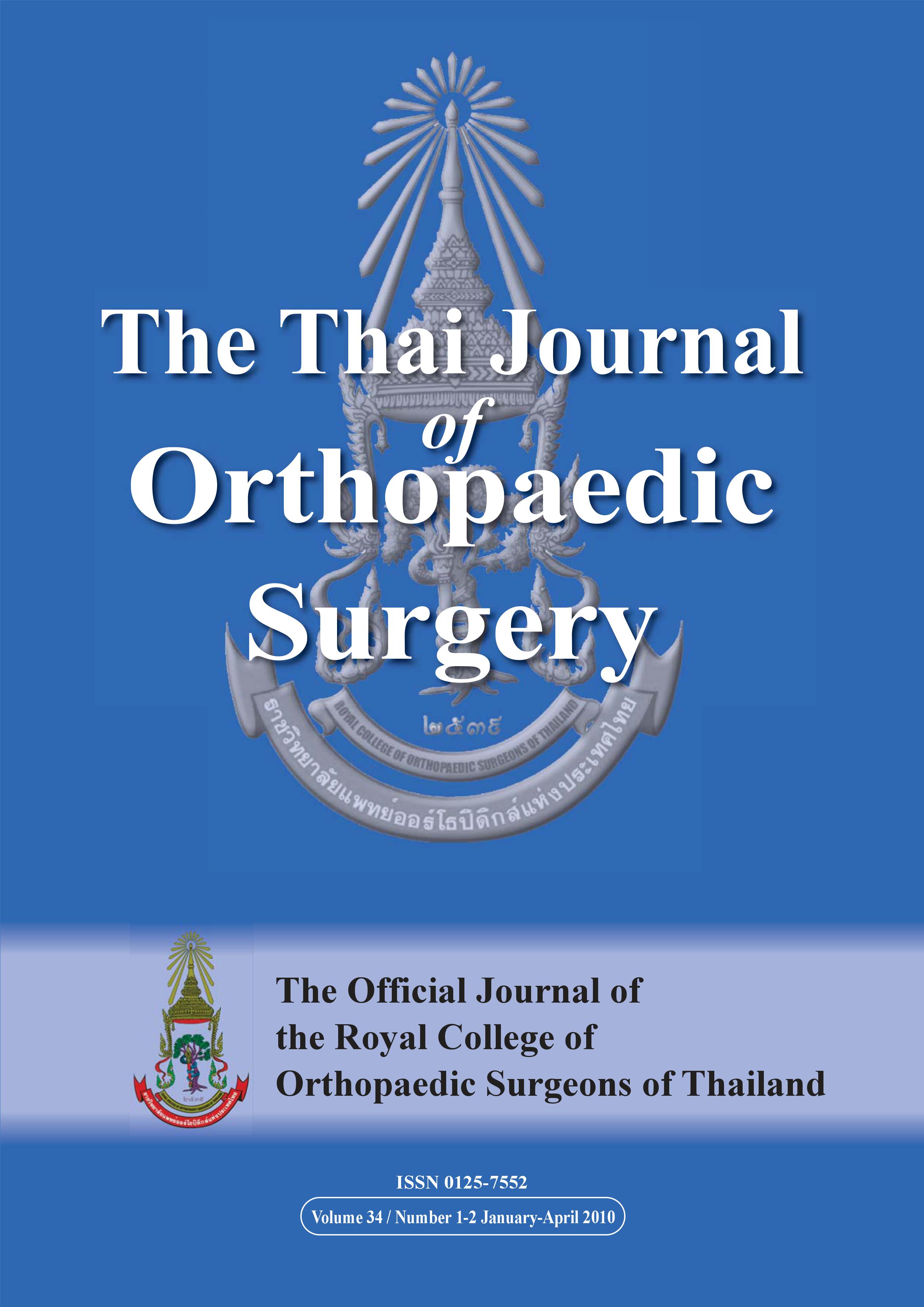การศึกษาระดับของครอสลิงค์เอ็นเทโลเป็บไทด์ของคอลลาเจนชนิดที่หนึ่งในปัสสาวะ ของสตรีไทยวัยเจริญพันธุ์และวัยหมดระดู
Main Article Content
บทคัดย่อ
วัตถุประสงค์: เพื่อศึกษาระดับปริมาณของครอสลิงค์เอ็นเทโลเป็บไทด์ของคอลลาเจนชนิดที่หนึ่งในปัสสาวะ(Urinary NTx) ในสตรีไทยวัยเจริญพันธุ์และวัยหมดระดู และความสัมพันธ์กับระยะเวลาที่หมดประจำเดือน และกับค่าความหนาแน่นกระดูก
วิธีการศึกษา: สตรีวัยเจริญพันธุ์จำนวน 48 คน และสตรีวัยหมดระดูจำนวน 42 คน ได้รับการเก็บปัสสาวะในตอนเช้าซึ่งเป็นปัสสาวะครั้งที่สองหรือสามของวันเพื่อมาตรวจวัดปริมาณของครอสลิงค์เอ็นเทโลเป็บไทด์ของคอลลาเจนชนิดที่หนึ่งด้วยกรรมวิธี ELISA กลุ่มสตรีวัยหมดระดูจะได้รับการตรวจวัดความหนาแน่นของกระดูกร่วมด้วย
ผลการศึกษา: ค่าเฉลี่ยของระดับครอสลิงค์เอ็นเทโลเป็บไทด์ของคอลลาเจนชนิดที่หนึ่งในปัสสาวะในกลุ่มสตรีวัยเจริญพันธุ์เท่ากับ 36.19 nM BCE/mM Cr, ค่าเบี่ยงเบนมาตรฐานเท่ากับ 25.18 ที่ระดับความเชื่อมั่น 95 เปอร์เซ็นต์ เท่ากับ 28.88 ถึง 43.50 nM BCE/mM Cr ค่าเฉลี่ยของระดับครอสลิงค์เอ็นเทโลเป็บไทด์ของคอลลาเจนชนิดที่หนึ่งในปัสสาวะในกลุ่มสตรีวัยหมดระดูเท่ากับ 58.89 nM BCE/mM Cr ค่าเบี่ยงเบนมาตรฐานเท่ากับ 26.93 ที่ระดับความเชื่อมั่น 95 เปอร์เซ็นต์ เท่ากับ 50.50 ถึง 67.28 nM BCE/mM Cr ผลการศึกษาพบว่า ไม่มีความสัมพันธ์อย่างมีนัยสำคัญทางสถิติระหว่างระดับครอสลิงค์เอ็นเทโลเป็บไทด์ของคอลลาเจนชนิดที่หนึ่งในปัสสาวะกับความหนาแน่นของกระดูก และกับระยะเวลาที่หมดประจำเดือน
สรุป: ระดับของครอสลิงค์เอ็นเทโลเป็บไทด์ของคอลลาเจนชนิดที่หนึ่งในปัสสาวะเพิ่มขึ้นตามอายุอย่างมีนัยสำคัญ (p< 0.0001) และมีความแตกต่างอย่างมีนัยสำคัญทางสถิติระหว่างกลุ่มสตรีวัยเจริญพันธุ์และกลุ่มสตรีวัยหมดระดู (p<0.0001)
คำสำคัญ: ครอสลิงค์เอ็นเทโลเป็บไทด์ของคอลลาเจนชนิดที่หนึ่ง, เอ็นทีเอ๊กซ์, วัยหมดระดู, กระดูกพรุน
Article Details
เอกสารอ้างอิง
2. Stork S, Stork C, Angerer P, Kothny W, Schmitt P, Wehr U, et al. Bone sialoprotein is a specific biochemical marker of bone metabolism in postmenopausal women: a randomized 1-year study. Osteoporos Int. 2000; 11(9): 790-6.
3. Delmas PD, Eastell R, Garnero P, Seibel MJ, Stepan J, Committee of Scientific Advisors of the International Osteoporosis Foundation (2000). The use of biochemical markers of bone turnover in osteoporosis. Committee of Scientific Advisors of the International Osteoporosis Foundation. Osteoporos Int.. 2000; 11(6): 2–17.
4. Henriksen K, Tanko LB, Qvist P, Delmas PD, Christiansen C, Karsdal MA. Assessment of osteoclast number and function: application in the development of new and improved treatment modalities for bone diseases. Osteoporos Int. 2007; 18(5): 681-5.
5. Pagani F, Francucci CM, Moro L. Markers of bone turnover: biochemical and clinical perspectives. J Endocrinol Invest. 2005; 28(10): 8-13.
6. Seibel MJ. Biochemical markers of bone turnover: part I: biochemistry and variability. Clin Biochem Rev. 2005; 26(4): 97-122.
7. Hanson DA, Weis MA, Bollen AM, Maslan SL, Singer FR, Eyre DR. A specific immunoassay for monitoring human bone resorption: quantitation of type I collagen cross-linked N-telopeptides in urine. J Bone Miner Res. 1992; 7(11): 1251-8.
8. Woitge HW, Pecherstorfer M, Li Y, Keck AV, Horn E, Ziegler R, et al. Novel serum markers of bone resorption: clinical assessment and comparison with established urinary indices. J Bone Miner Res. 1999; 14(5): 792-801.
9. Gertz BJ, Shao P, Hanson DA, Quan H, Harris ST, Genant HK, et al. Monitoring bone resorption in early postmenopausal women by an immunoassay for cross-linked collagen peptides in urine. J Bone Miner Res. 1994; 9(2): 135-42.
10. Abe Y, Ishikawa H, Fukao A. Higher efficacy of urinary bone resorption marker measurements in assessing response to treatment for osteoporosis in postmenopausal women. Tohoku J Exp Med. 2008; 214(1): 51-9.
11. Seibel MJ. Biochemical Markers of Bone Turnover Part II: Clinical Applications in the Management of Osteoporosis. Clin Biochem Rev. 2006; 27(3): 123-38.
12. Bunyaratavej N. Monitoring of Risedronate by biochemical bone markers in clinical practice. J Med Assoc Thai. 2005; 88(5): 34-6.
13. Bunyaratavej N, Kittimanon N. Study of procollagen type1 nitrogenous propeptides (P1NP) in reproductive female. J Med Assoc Thai. 2005; 88(5): 27-8.
14. Bunyaratavej N, Soontrapa S, Rojanasthin S, Kitimanon N, Lektrakul S. Level of undercarboxylated osteocalcin in reproductive Thai females. J Med Assoc Thai. 2005; 88(5): 37-9.
15. Soontrapa S, Soontrapa S, Bunyaratavej N. Serum concentration of undercarboxylated osteocalcin and the risk of osteoporosis in thai elderly women. J Med Assoc Thai. 2005; 88( 5): 29-32.
16. Bunyaratavej N, Kitimanon N, Boonthitikul S. Study of the level of biochemical bone markers: NMID osteocalcin and bone resorptive marker (beta CTx) in Thai women. J Med Assoc Thai. 2001; 84(2): 560-5.
17. Sone T, Miyake M, Takeda N, Fukunaga M. Urinary excretion of type I collagen crosslinked N-telopeptides in healthy Japanese adults: age- and sex-related changes and reference limits. Bone. 1995; 17(4): 335-9.
18. NIH Consensus Development Panel on Osteoporosis Prevention Diagnosis and Treatment. Osteoporosis prevention, diagnosis, and therapy. JAMA. 2001; 285(6): 785–95.
19. Assessment of fracture risk and its application to screening for postmenopausal osteoporosis. Report of a WHO Study Group. World Health Organ Tech Rep Ser. 1994; 843: 1-129.


